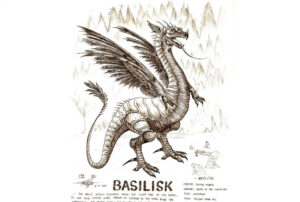Table of Contents
The Pontianak is often associated with a particular tree, the “pokok pontianak” or pontianak tree, which is believed to be the site where the woman died. The spirit is said to manifest as a beautiful woman, often wearing a white dress, and can be found in areas such as graveyards, forests, or remote places. In some versions of the legend, the Pontianak is also said to have long hair that conceals fangs.
One of the distinctive characteristics of the Pontianak legend is its ability to shapeshift. The spirit can transform into various forms, including a beautiful woman to attract men before revealing its true nature. The Pontianak is also associated with a chilling cry that is said to resemble the cry of a baby, luring unsuspecting victims.
Different regions may have variations of the Pontianak myth, and the creature is known by different names in different cultures. Despite its terrifying reputation, the Pontianak legend is often used in popular culture, including movies and literature, to evoke fear and suspense.
Origin

The legend typically revolves around the tragic death of a woman during childbirth or while pregnant. This untimely death is often portrayed as unjust or resulting from a traumatic event. The spirit of the deceased woman is then said to transform into a Pontianak, a vengeful and malevolent entity.
The association of the Pontianak with a specific tree, known as the pontianak tree, adds to the folklore’s mystique. It’s believed that the spirit is somehow linked to this tree, where the woman may have died or been buried.
Over time, the Pontianak legend has become deeply ingrained in the cultural consciousness of the region, and it continues to be a popular theme in local stories, movies, and other forms of artistic expression. The myth serves as a cautionary tale, often warning against certain behaviors or actions that may lead to tragic consequences.
Physical Description
Beautiful Appearance: It is often described as a beautiful woman, adding an element of allure to her supernatural nature. This beauty is sometimes used to deceive or attract unsuspecting victims.
White Dress: In many accounts, the Pontianak is said to wear a flowing white dress. This attire may symbolize purity or may be linked to burial customs, as white is often associated with death and mourning in many cultures.
Long Hair: The Pontianak is often depicted with long, disheveled hair. This hair may be used as a symbolic representation of mourning or as a visual cue for the eerie and supernatural nature of the spirit.
Vengeful Expression: The Pontianak’s face may bear a vengeful or menacing expression, especially when she reveals her true nature. This expression reflects her purpose as a vengeful spirit seeking retribution for her untimely death.
Shapeshifting Abilities: One of the distinctive characteristics of the Pontianak is its ability to shapeshift. The spirit can transform into different forms, including that of a beautiful woman to attract victims or a more terrifying form when revealing its true nature.
Personality

The personality of the Pontianak in folklore is often characterized by a mix of beauty and malevolence. Here are some common traits associated with the personality of the Pontianak:
Vengeful: The Pontianak is typically depicted as a vengeful spirit seeking retribution for the injustice or tragedy that led to her death. This vengeful nature is a central theme in many Pontianak stories, and the spirit may target individuals who have wronged her in some way.
Deceptive: In some versions of the legend, the Pontianak is known for her ability to deceive. She may initially appear as a beautiful and alluring woman, using her charm to attract unsuspecting victims. This deception adds an element of suspense and fear to the folklore.
Protective of Women and Children: Despite her vengeful nature, there are variations of the Pontianak myth that depict her as protective of women and children. In these versions, she may target men who pose a threat to women or harm children.
Mourning and Sorrow: The Pontianak is often associated with themes of mourning and sorrow due to her tragic death during childbirth or while pregnant. This sorrowful aspect of her personality adds a layer of empathy, emphasizing the injustice of her fate.
Lonely Spirit: The Pontianak is sometimes portrayed as a lonely spirit condemned to roam the earth. Her loneliness may contribute to her vengeful nature, as she seeks solace or justice for the events that led to her death.
Shapeshifter: The Pontianak’s ability to shapeshift adds complexity to her personality. This trait allows her to take on different forms, ranging from a beautiful woman to a terrifying entity, enhancing her ability to deceive and frighten.
Explanation of the Myth
The Pontianak myth originates from Southeast Asian folklore, particularly in Malay and Indonesian cultures. The myth revolves around the tale of a woman who dies during childbirth or while pregnant, experiencing a tragic and untimely death. The spirit of this deceased woman transforms into a Pontianak, a vengeful and malevolent entity that seeks retribution for the circumstances surrounding her demise.
An explanation of the key elements of the Pontianak myth:
Tragic Death: The Pontianak myth often begins with the tragic death of a woman during childbirth or pregnancy. This death is portrayed as unjust, resulting from a traumatic event, and serves as the catalyst for the transformation into a Pontianak.
Vengeful Spirit: The spirit of the deceased woman becomes a vengeful Pontianak, driven by a desire for revenge against those responsible for her tragic fate. This vengeance may target specific individuals or may be more indiscriminate, affecting anyone who crosses her path.
Shapeshifting Abilities: One of the distinctive features of the Pontianak is her ability to shapeshift. This allows her to take on different forms, often appearing as a beautiful woman to attract victims before revealing her true, more terrifying nature.
Deception and Allure: The Pontianak is known for her deceptive tactics. She may appear as a beautiful and alluring woman to attract unsuspecting victims, luring them into a false sense of security before revealing her true intentions.
Connection to a Specific Tree: The Pontianak is often associated with a particular tree, known as the pontianak tree. This tree is believed to be linked to the site of the woman’s death and may play a symbolic role in the myth.
Cry of a Baby: Another characteristic of the Pontianak myth is the eerie cry that resembles the cry of a baby. This cry is said to be used by the Pontianak to attract attention or lure potential victims.
The Pontianak myth serves as a cautionary tale, warning against actions or behaviors that may lead to tragic consequences. It reflects cultural beliefs and societal values, often exploring themes of justice, vengeance, and the supernatural. Over time, the myth has become a prominent element in local folklore and has been adapted in various forms of literature, movies, and other cultural expressions. Different regions may have their own variations of the Pontianak myth, adding richness and diversity to the overall narrative.
In Modern Usage and Symbolism

In modern usage and symbolism, the Pontianak myth continues to play a significant role, particularly in the cultural and entertainment spheres of Southeast Asia. Here are some ways in which the Pontianak is employed in contemporary contexts:
Horror Genre: The Pontianak has become a popular figure in the horror genre, both in literature and film. Numerous horror movies in Southeast Asia feature the Pontianak as a central character, using her vengeful and supernatural nature to evoke fear and suspense.
Cultural Identity: The Pontianak myth is deeply rooted in the cultural identity of the region. Its continued presence in contemporary storytelling helps to preserve and promote cultural heritage, offering a connection to traditional beliefs and folklore.
Tourism and Pop Culture: The Pontianak myth has found its way into various forms of popular culture, including tourism. Some regions celebrate or capitalize on the legend to attract visitors interested in experiencing the cultural and supernatural aspects associated with the Pontianak.
Symbol of Femininity: The Pontianak, often portrayed as a female spirit, can be seen as a symbol of femininity. Her tragic backstory, related to childbirth, may evoke empathy and raise awareness about issues related to women’s well-being and maternal health.
Metaphor for Injustice: The Pontianak myth is sometimes used as a metaphor for injustice. The vengeful nature of the spirit reflects a desire for retribution and justice, and this theme can be applied to broader societal issues or personal struggles.
Adaptations in Popular Media: The Pontianak has been adapted in various forms of media beyond traditional storytelling, including comics, video games, and digital content. These adaptations often reinterpret the myth to suit contemporary audiences while retaining its core elements.
Supernatural Entertainment: Beyond horror, the Pontianak is sometimes incorporated into broader supernatural and fantasy narratives. Her shapeshifting abilities and connection to the spirit world make her a versatile character in modern speculative fiction.
In modern contexts, the Pontianak continues to evolve and adapt, maintaining its relevance in the cultural landscape of Southeast Asia. Whether through traditional storytelling or contemporary media, the Pontianak remains a powerful symbol that resonates with audiences and contributes to the rich tapestry of folklore in the region.
Related similar creatures
Kuchisake-onna (Japan): Also known as the Slit-Mouthed Woman, Kuchisake-onna is a Japanese urban legend about a woman who wears a surgical mask and asks individuals if they think she is beautiful. Depending on the response, she may reveal a disfigured mouth, often resembling a slit, and harm the person. Her origin is often linked to a woman who was mutilated by her husband in a fit of jealousy.
La Llorona (Mexico and Latin America): Translated as “The Weeping Woman,” La Llorona is a ghostly woman who, according to legend, drowned her children and now mourns their loss by crying along rivers or lakes. The story is a cautionary tale, warning children about the dangers of wandering near bodies of water.
Yurei (Japan): Yurei are vengeful spirits in Japanese folklore, often depicted as women with disheveled hair and white burial kimono. Similar to Pontianak, Yurei may seek revenge for a tragic death or betrayal. They are commonly associated with onryo, spirits with a strong desire for vengeance.
Churels (South Asia): In South Asian folklore, particularly in India and Pakistan, Churels are female spirits believed to be the ghosts of women who died during childbirth or under tragic circumstances. They are often depicted as seductive, luring men before revealing their true, horrifying form.
White Lady (Various Cultures): The White Lady is a common motif in various cultures, often representing a ghostly woman in white who may appear near bodies of water, graveyards, or other haunted locations. Stories of White Ladies are found in European, American, and Asian folklore.
Mae Nak (Thailand): The story of Mae Nak is a Thai ghost story about a pregnant woman who died during childbirth. Unaware of her death, she continues to live with her husband and child as if nothing has changed. The tale explores themes of love, loss, and the supernatural.
Llorona (Philippines): In the Philippines, the term “Llorona” is used to describe a similar spirit, often a woman who died during childbirth or under tragic circumstances. The myth shares similarities with the La Llorona legend found in Latin America.
These examples illustrate the universality of themes in folklore and mythology, where stories of female spirits seeking justice or revenge are found in various cultures around the world. While the details and cultural contexts may differ, these legends often serve as cautionary tales or reflections of societal fears and values.
FAQ
What is a Pontianak ghost?
A Pontianak ghost is a supernatural entity in Southeast Asian folklore, particularly in Malay and Indonesian mythology. It is often depicted as the spirit of a woman who died during childbirth or while pregnant. The Pontianak is known for its vengeful and malevolent nature, seeking retribution for the circumstances surrounding its death.
What is the story behind Pontianak?
The story behind the Pontianak involves the tragic death of a woman during childbirth or pregnancy. The spirit of this deceased woman transforms into a Pontianak, a vengeful entity that may take on the appearance of a beautiful woman to attract victims before revealing its true, terrifying nature. The Pontianak is often associated with a specific tree and is known for its shapeshifting abilities.
Is the Pontianak real or fake?
The Pontianak is a mythical creature rooted in folklore and is not considered real in a literal sense. It is a cultural legend and supernatural entity that has been passed down through generations in Southeast Asian traditions. The Pontianak is used in storytelling and cultural expressions but is not an actual, tangible phenomenon.
What is Pontianak known for?
Pontianak is known for its role in Southeast Asian folklore as a vengeful female spirit associated with tragic deaths during childbirth or pregnancy. It is a popular figure in horror stories, movies, and cultural expressions, contributing to the rich tapestry of myths in the region.
What to do if you see a Pontianak?
Traditional beliefs suggest various precautions if one encounters a Pontianak, such as avoiding certain areas associated with the spirit, reciting prayers, or carrying protective talismans. However, these practices are rooted in folklore and cultural traditions.
What is the gender of Pontianak?
The Pontianak is often depicted as a female spirit. The myth typically revolves around the spirit of a woman who died under tragic circumstances during childbirth or pregnancy.
What is the religion in Pontianak?
Pontianak is also the name of a city in Indonesia. The predominant religion in Pontianak, the city, is Islam. However, when referring to the Pontianak ghost in folklore, it is not associated with a specific religious context but rather cultural and supernatural beliefs.
What language is spoken in Pontianak?
In the city of Pontianak, the predominant language is Indonesian. However, various ethnic groups in the region may also speak their respective languages and dialects.
What is the difference between Langsuir and Pontianak?
Both Langsuir and Pontianak are female spirits in Malay and Indonesian folklore, often associated with tragic deaths during childbirth. The Langsuir is sometimes considered an evolved or different form of the Pontianak. While both are vengeful spirits, the Langsuir is characterized by its long, flowing hair and is said to have the ability to fly.
How do you pronounce Pontianak?
Pontianak is typically pronounced as "pon-tee-ah-nak," with the emphasis on the first syllable.
How do you spell Pontianak?
The correct spelling is "Pontianak."




